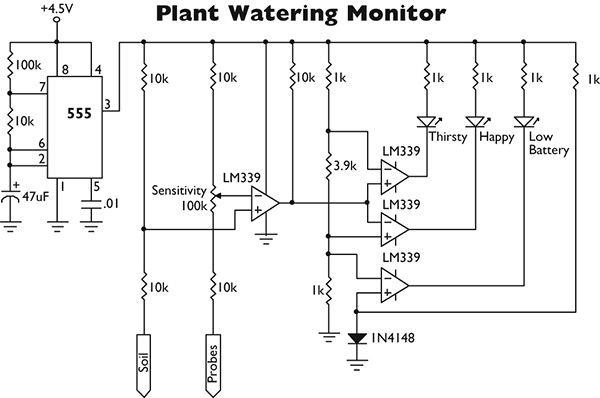I’m Thirsty, Water Me
Question:
Cold weather has forced me to move my potted plants indoors. Now, I’d like to build a plant-watering monitor so that I know when a plant is thirsty and when it’s feeling fine. I saw a Plant Watering Monitor kit in a UK catalog, but the value difference between the Sterling pound and US dollar, along with the shipping, is enough to discourage me from buying it.
Basically, it has an LED for “Water OK,” one for “Needs Water,” and one for when the batteries (four AA cells) are low. It advertises a long battery life by flashing the LEDs rather then have them run steady-state. Do you have an equivalent design that I can make with readily available parts? No microcontrollers, please.
L. A. S.
via Internet
Answer:
What you ask for can be done using a single LM339 comparator chip that sells for less than $.50. The first of the four comparators senses the moisture of the soil by measuring its conductivity (resistance). The “Sensitivity” control lets you set the trip point for a wide range of soil types and moisture conditions.

When the plant is happy, the output of the comparator is high — which, in turn, lights the “Happy” LED. As the resistance of the soil increases — loses moisture — the comparator output flips to the low state and lights the “Thirsty” LED. The “Low Battery” comparator is biased so that, when the battery voltage drops below 4.0 volts, the LED lights.
To extend battery life, I’ve powered the comparator chip and LEDs with a voltage that’s off for about 4 seconds and on for 1/3 of a second using a CMOS LMC555 astable multivibrator. That is, every four seconds, a voltage is applied to the LM339 and LEDs for 1/3 of a second — a flash — resulting in a duty cycle of 8 percent. The average current draw is typically 400 µA — which means your AA cells will easily last through the winter. Increasing the 47 µF cap to 100 µF will nearly double the battery life.


Comments